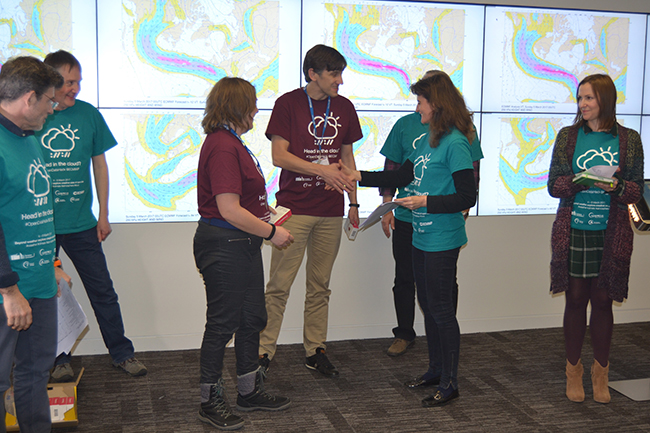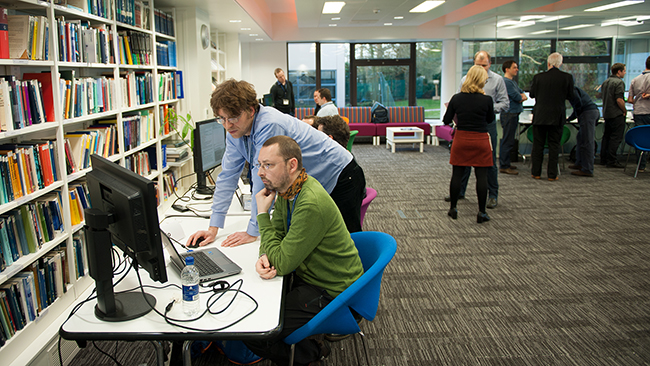

Twenty teams worked day and night at the #OpenDataHack event hosted by ECMWF on 4 and 5 March to explore creative uses of open weather and climate data.
The teams, made up of over 70 developers, scientists and other data enthusiasts, were set three challenges: Get Out; Get Geeky; and Get Creative.
Local transport operator Reading Buses and the Snowflake Software company provided additional datasets.
Described as ‘epic’ and ‘beautiful’ by participants and observers, the hackathon saw four teams declared as winners by a panel of experts led by ECMWF Director-General Florence Rabier.
The event aimed to raise awareness of freely available data from ECMWF and three EU-funded Copernicus services: the Climate Change Service (C3S) and the Atmosphere Monitoring Service (CAMS), which are operated by the Centre, and the Emergency Management Service (CEMS) run by the Joint Research Centre.
It was part of ECMWF’s Open Data Week as well as of international Open Data Day.
Earlier in the week, 40 international climate and weather specialists from Europe and the US debated ways to improve the socio-economic impact of numerical weather prediction (NWP) data.
A biennial workshop on meteorological operational systems (MOS), attended by over 60 experts from across the world, was also part of the week. This year it focused on how data can best be brought to users.
And the winner is…
“All #OpenDataHack teams came up with creative ideas and demonstrated the importance of combining open weather and climate data with other open data,” says hackathon organiser Julia Wagemann.

The organisers praised the hackathon participants for their creative ideas. (Photo: Maurizio Latini)
But winners had to be declared and declared they were.
The winner of the Get Out challenge was the HydroNEXT project, which set up a web application that uses river discharge forecast data from GloFAS and river flow data from SWICCA to calculate the projected energy generation of a hydroelectric plant.
The winner of the Get Geeky challenge was the project Reading Buses accident and breakdown prediction, which set up a machine-learning model that predicts the probability of accidents for buses in response to weather conditions.
Besides bus data, the model uses climate reanalysis data, such as total precipitation, snow fall, evaporation and total column ozone.
The Get Creative category had two winners.
Team Diversity investigated the impact of weather and climate on animal migration in Kenya, based on a geospatial analysis.
The second first place was awarded to team CWS+, which developed a water disease prevention system for Kenya. Based on rainfall predictions, the system predicts the likelihood of diseases, droughts, water shortage problems and floods.

ECMWF Director-General Florence Rabier congratulated the winners of the hackathon. (Photo: Maurizio Latini)
Socio-economic impact
The workshop on improving the socio-economic impact of NWP data, held at the Centre from 28 February to 1 March, was aimed at policy-makers and professionals interested in the evolution of the meteorological industries.
It provided a forum to discuss the challenges linked to the dissemination of large sets of meteorological data.
“A forecast has no value until it is understood and changes behaviour – this single sentence encapsulates the workshop,” says ECMWF Deputy Director of Forecasts Erik Andersson.
It means that implementing open data by just publishing vast amounts of it is not good enough. “The data needs to be made digestible by means of innovative data discovery, selection and access systems.”
A comprehensive set of workshop highlights and group activity discussions (PDF) has been published on ECMWF’s website
Where are operational data services heading?
Speakers at the workshop on meteorological operational systems from 1 to 3 March looked into who is best placed to process big data.
“Presentations from services around the world showed that the current trend is to bring the processing to where the data is,” says workshop organiser Stephan Siemen.
“The amount of data stored at various centres is simply too large to be moved to users,” he explains.

The workshop on meteorological systems included an exhibition of operational visualisation systems.
Participants were able to see various web and desktop solutions offering data processing and visualisation capabilities.
The workshop included its traditional exhibition of operational visualisation systems.
Top photo: Maurizio Latini
